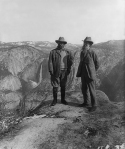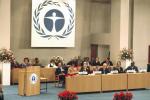Darwall tells how it was conservative governments who were the first to raise the alarm.
 In Australia and the USA today the politics of global warming falls fairly predictably across the right/left spectrum. Upon ascending to power in September, Tony Abbott could hardly wait to start abolishing a bunch of climate change qangos set up under Labor. Even before parliament had convened for the first time, the new conservative Australian government had launched their plan for rolling back Labor’s carbon tax and they had also sent into the latest round of UN treaty negotiation a strong message of resistance wrapped in anti-leftist sentiment.
In Australia and the USA today the politics of global warming falls fairly predictably across the right/left spectrum. Upon ascending to power in September, Tony Abbott could hardly wait to start abolishing a bunch of climate change qangos set up under Labor. Even before parliament had convened for the first time, the new conservative Australian government had launched their plan for rolling back Labor’s carbon tax and they had also sent into the latest round of UN treaty negotiation a strong message of resistance wrapped in anti-leftist sentiment.
[Australia] will not support any measures
which are socialism masquerading as environmentalism (1)
All this is reminiscent of 2001, when George W Bush could hardly wait to announce that he was rolling back the excesses of Clinton-Gore. The scene is not so straightforward in the UK. But even under David Cameron, where the old dark blue of the Tories has been lightened by a tide of green, warming alarm looks like a push from the left, while skepticism is a pushing back from the right. Lord Lawson’s launch in 2009 of the Global Warming Policy Foundation (to which John Howard recently gave a much publicized speech) fits with just such a pushing back against a weakening of conservative resolve. However, Rupert Darwall’s historical study, The Age of Global Warming, tells a more complex story, where there are deep historical sympathies of conservatism with the global warming scare. Moreover, it was conservative governments who succeeded in first raising the global alarm.
During the twilight years of her decade-long domination of British politics, Margaret Thatcher capitalised on her scientific background in four powerful and considered speeches on global warming.
The first of these was delivered in the autumn of 1988 to her fellows at the world’s premier state-instituted scientific organization, the Royal Society. Emphasizing greenhouse warming among international environmental concerns, this speech marked a volte-face for a government previously criticized as tardy in coming to the table on the other international environmental issues about which she boasted action, namely acid rain and ozone depletion. The surprise recruitment of Thatcher to the environmental cause undoubtedly added to the excitement generated in North America during that fateful summer of 1988 (see here). It added to the push within the United Nations for a climate treaty and for the strengthening of the mandate of the Intergovernmental Panel on Climate Change (IPCC).
While at the Royal Society, Thatcher cautioned the scientists that an assessment of the effects of greenhouse gas emissions should be ‘founded on good science to establish cause and effect,’ this message soon shifted. The following year Thatcher continued to emphasis ‘sound scientific analysis,’ but now as the basis of the measures taken to mitigate climate change. In a full 30 minute address to the UN General Assembly in November 1989, Thatcher left no doubt that immediate action on emissions is required. ‘We can’t just do nothing’ she insisted, and she joined the call for a framework convention followed by binding protocols to control emissions. Later in that session of the General Assembly, the World Meteorological Organization (WMO) and the UN Environment Program (UNEP) were directed to ask their newly established climate panel to go beyond their assessment of the greenhouse effect, of its impacts and of the various ways of mitigating climate change. The IPCC was also asked to begin preparations for just such a climate convention. In her UN speech, Thatcher boasted her government’s coordinating role in the IPCC, the report of which she said ‘will be available to everyone by the time of the Second World Climate Conference next year.’ But Thatcher herself was not going to wait that long.

Margaret Thatcher with John Houghton opening the Hadley Centre, May 1990. (Source: WMO )
The assessment of the scientific basis for action had been assigned to the IPCC Working Group I, which scheduled a meeting to finalise its report in Windsor, England, May 1990. These working group meetings are closed to the press while the governmental delegates agree line-by-line to a summary of the expert report. Once agreed, each of the three working groups then submits their report and summary to a full meeting of the IPCC, which, for the first assessment, would be held in Sundsvall, Sweden later in the year. Only once accepted by the panel would it become the official assessment of the panel. Just as Thatcher had indicated in her UN speech, the plan was to present to the world this freshly minted assessment at the Second World Climate Conference in November. However, in her UN speech Thatcher had also announced that the UK would establish a new centre for ‘the prediction of climate change.’ The opening of this ‘Hadley Centre’ was planned for the end of the week of the Working Group I meeting in Windsor the following May – long before the World Climate Conference. During the week, Thatcher had the British chair of the Working Group, John Houghton, brief her on the draft summary of the report. By incorporating the as-yet-unannounced working group findings into her opening speech, Thatcher achieved quite a scoop.

Gummer, Houghton, Major, Tickell & Selbourne at the launch of the Government Panel on Sustainable Development in 1994. (Source: WMO)
By this time the WMO’s World Climate Conference came around, environmental concerns were well established in Thatcher’s global policy profile, and there again she took the opportunity to join the chorus calling for action. But while Thatcher’s support undoubtedly empowered their cause, it is hard to see how this grandstanding on global action helped her win any support back home. Then perhaps, at that stage, nothing could; and returning home must have been a sobering experience for Margaret Thatcher. With the bright flame of Thatcherism receding, she arrived to find her government collapsing around her. It would soon die down into the smouldering and spluttering continuance of Tory government under John Major. Nevertheless, there remained John Gummer (Lord Deben), perhaps the most enthusiastic supporter of climate action of any member of any government of Great Britain. As environment minister under John Major, he would carry the flame for the Iron Lady all the way to Kyoto.
Sustainable Thatcher
Thatcher was astute with the science and sober in her assessment. Crispin Tickell, a prominent conservative diplomat, had encouraged her to take a stand on global environmental issues, and this one in particular, but she did not take his word for it, nor rely on political advisors. Instead, she consulted directly with Britain’s leading climatic researchers. These included John Houghton, who had been picked for his role in the IPCC while already the head of the British Meteorological Office. At times she also worked closely with Tom Wigley, the head of the Climatic Research Unit at University of East Anglia. Thatcher’s diligence with the science shows through in some of the most accurate and circumspect summaries of the IPCC’s assessment of any political leader at the time or since. Indeed, Tickell and Thatcher both recognised the speculative nature of the science as it stood. Thatcher even makes reference to the finding of Tom Wigley in his chapter of the IPCC assessment, which concludes that the human influence on global climate still had not been detected and that it is unlikely to be detected for decades. But Thatcher, again following Tickell (1986), did not see the lack of empirical confirmation as cause for delay in taking action to drastically reduce emissions. Thus, it was in full knowledge of the less-than-conclusive findings of the IPCC that Thatcher supported the plans to have a framework convention ready for signing at the Rio Earth summit in 1992, and for this to pave the way for protocols delivering legally binding emission reduction targets.
In her calls for climate action, it was a shock to many on both sides of the debate how Thatcher played the complete convert to the environmental cause. Her advocacy of precautionary action on prospective global warming was always presented in the context of a much grander cause which is the urgent need for cooperative action to protect the fragile global environment. In this she was early to embrace the language and scope of the ‘sustainable development’ movement as it had only recently been formulated in the Brundtland Report. After a late start, Thatcher had leaped to the front of the pack of world leaders campaigning on this issue. For it was only after she was prised off the stage by her Tory colleagues, only at the Rio earth summit in 1992, that all the aspirations of the sustainability movement was fully channelled into the campaign for a climate treaty.
Margaret Thatcher’s role in propelling the global warming scare onto the geo-political stage is only one small part of the story that Rupert Darwall offers in his The Age of Global Warming, a wide ranging study of the political phenomenon that is the global warming scare. But it is an important part, for it highlights the role that conservative governments played in the early scenes of this story. Their role is often neglected in other histories such as Booker’s less ambitious and much more readable The Real Global Warming Disaster.
Revolutionaries enter stage right

Canadian environment minister (McMillan) and Canadian prime minister (Mulroney) flanking the author of the Brundtland Report at the Toronto ‘changing atmosphere’ conference in 1988. Gro Brundtland was exceptional among heads of state calling for climate action in that she came from the left side of politics. (Source)
Across the Atlantic, the Canadian Tories were also instrumental in exciting global interest. One event widely recognised as pivotal was an international conference ‘on the changing atmosphere’ held in Toronto in the Summer of 1988 (i.e., a few months before Thatcher’s Royal Society speech). There, Prime Minister Brian Mulroney played host to what is perhaps the most alarmist climate conference of all time, remembered especially for the opening sentence of its agreed concluding statement: ‘Humanity is conducting an unintended, uncontrolled, globally pervasive experiment whose ultimate consequences could be second only to a global nuclear war.’ (more here)
At the time Ronald Reagan was also active on the environmental policy front, although less engaged with UN initiatives and apparently rather cynical. But it was his vice president, George Bush, who presented as much more genuine. In something of an environmental policy bidding war during the 1988 presidential campaign, Bush committed to tackling greenhouse warming. Arriving in the top job in 1989, President Bush delivered on his promise not only by increasing once again the funding for environmental research, but also in getting right behind the UN push for a climate convention and so behind its newly formed climate panel.
Considering the low profile of the IPCC at the time, the showering of attention by the new US administration shocked many of the scientists involved. First there was Bush’s secretary of state, James Baker, choosing for his first public address the opening of a meeting of one of its working groups, Working Group III. There was some strategic sense in this, as it was at the time when all the attention of other government delegations was shifting towards this working group because it was starting to look every bit like the framework convention would be taking shape there. (No doubt, anticipating this, the American delegation had already got their man, Bernthal, in the chair.) Then Bush himself stepped up to show his personal support for climate research and climate action in a gushing address to a full meeting of the IPCC early in 1990 (see IPCC III pdf). (Remember that since the events of 1988, the Berlin Wall had come down and with it the risk of that other environmental catastrophe, nuclear war.)
Boasting of still further increases in the funding of environmental research, Bush, like Thatcher, also acknowledged the dearth of ‘hard data’ to support climate action. On this matter there was much hand-wringing at the time within the IPCC, including by the Chairman, Bert Bolin. But Bush was reassuring: ‘Where politics and opinion had outpaced the science’ he pledged support of his government by funding science and technology to ‘bridge the gap.’ Bush also reiterated a previous offer to host the first negotiation for a framework convention in Washington once the IPCC has completed its work. The US did host that first negotiation, and Bush went on to Rio to join other state leaders in signed the Framework Convention on Climate Change (FCCC).
After more than a decade of Republican reign, Bush’s signing of the FCCC marked the height of US government enthusiasm for the global effort to mitigate the greatest environmental disaster of all time. But Bush’s enthusiasm for climate action did concern those of the anti-regulation, laissez-faire persuasion prevailing on the right side of politics at the time. In Darwall’s view, when first Bush and other conservative leaders jumped on the greenhouse bandwagon, they gave little thought to the economic consequences of mitigation. Indeed, no-one seems to have done any proper economic analysis until early in the Bush Administration when some of his hard-nosed minders set to doing the sums. The astounding results—of the cost/benefit analysis, of the impact on GDP, etc—soon percolate up into a more reticent attitude by the time there was serious discussion about commitment to emissions controls. But by then it was the Democrats turn.
When the Democrats finally came back into power, not only Vice-President Gore, but also the less enthusiastic President Clinton, tried as they could to take the matter that one critical step further. It was only that when they did, it all fell apart. At CoP2 in 1996, the head of the US delegation, Tim Wirth, did announce that the US was now ready to commit to binding emissions targets, but the backlash among senators on both sides of the house was so overwhelming that nothing could be done. The US government would never again take leadership on this issue.
And so we have a left wing government finally coming into power only to then drop the ball on the greatest environment cause of all time. This monumental failure is a stark contrast to the preceding achievements of conservative governments in getting the whole thing started. This was not only in the governments of Mulroney, Thatcher and Bush forged the initial path. Once the FCCC was in place, John Gummer was not alone among European conservatives in pushing for binding emissions targets. The UK environment minister soon had a particularly strong ally among the German Christian Democrats in the rising star of Angela Merkel. Shortly after stepping up into the environment ministry of Helmat Kohl’s conservative government, we find Merkel’s masterful performance chairing the first conference of parties to the framework convention – ‘CoP1,’ the meeting where the ‘Berlin Mandate’ was achieved. Gummer and Merkel would then make every effort to keeping up the momentum all the way to Kyoto.
In order to understand the affinity of political conservationism with the global warming scare, Darwall pulls back on the scope to tell a much grander tale of the development of modern political ideology over the last century and more. In this way we see how global warming realized tendencies long established. Indeed, it was heading this way all along, hence the title: The Age of Global Warming.
Conservative Conservationism

Ruckelshaus is sworn in as head of the new EPA, Dec 1970. (Source AP/Charles Tasnadi)
If we need reminding of the early conservative enthusiasm and success in promoting the global warming scare, then it is also worth noting that this concern for the environment and conservation only follows in a Republican tradition. Richard Nixon hardly fits the picture of the passionate conservationist, but it was his administration that initiated the big federal spend on the environment, including with the establishment of the US Environment Protection Authority—the first act of which was the banning of DDT in a highly politicized decision to appease what had become a formidable environmental lobby (more here). More of the picture of a passionate conservationist is found much further back with the patriarch of North American conservative conservationism, Ted Roosevelt—and he comes complete with his links to the American romantic naturalism of late 19th century.

President Theodore Roosevelt (left) with the founder of the Sierra Club, John Muir, Yosemite National Park, 1908. While later in the 20th century Roosevelt’s Republicans would shy away from promoting depletionism, the Serra club continued to do so, including by sponsoring Ehrlich’s Population Bomb. (Wikipedia)
It was President Roosevelt who announced the end of the frontier mentality and who shifted attention towards the care and conservation of the countries finite natural resources. And here we are not only talking about the preservation of forests and the creation of national parks. Roosevelt raised alarm about the prospect of mineral resource depletion. Of special concern was the depletion of petroleum oil, for which there was exponential demand but limited known reserves. Darwall explains how, during the First World War, depletionism became something of a self-fulfilling prophecy in an energy crisis that is often now seen as due less to a shortage but more to regulation designed to manage it.
The use of government regulation to address concern about resource depletion was not something ever again picked up by Roosevelt’s following Republican. Instead, it was President Jimmy Carter who would use this strategy during and following the OPEC oil crisis—and with disastrous results. But the reason Darwall recounts this story about early responses to depletion anxieties is that, in a much more general way, the Republican-backed movement to mitigate global warming has very strong affinities with Roosevelt’s regulatory response to the mineral depletion scares. Indeed, the control of greenhouse gas emissions has strong affinities with resource conservation, and it generally serves the same end. What has happened is that warming mitigation has become a channel for the aspirations of conservationism more generally. This is seen more clearly in the development of the global environmental movement within the United Nations, which Darwall notes came in two distinct waves.
Two waves to warming

The UN Stockholm Conference of 1972 is addressed by Indira Gandhi, Prime Minister of India, where she links environmental protection with development goals. (Source)
The first wave of global environmentalism peaked 20 years before the UN Environment Program’s Earth Summit in Rio. This was at the forerunner to Rio, the 1972 conference in Stockholm where the Environment Program was born. The global environment movement had emerged out of localised campaigns in the affluent west which then coalesced into a movement towards the care and conservation of the finite and vulnerable natural resources of the entire globe. This is where the birth of the modern American environment movement in the organic pesticides scare of the 1950s and 1960s is important, including the much flaunted influence of Rachel Carson’s Silent Spring (1962) complete with its frightening passages on the insidious chemical-driven cancer pandemic. But Darwall’s story gives more weight to a new movement that took off a decade later and that has strong affinities to the early depletionism of the Roosevelt era. This is the global Malthusianism popularised by such publications as The Population Bomb (1968), The Limits to Growth (1972), and Only One Earth (1972). In order to mitigate the looming disasters at the limit of growth, the argument goes, we must shift from our addiction to continuous economic expansion.
This anti-growth imperative created tensions on the left of politics in the various wealthy countries. In particular, it caused resistance among the traditional left where it saw itself advocating for the working classes. The poorer classes have a conflicting interest in the expansion of employment and the expansion of affluence that could be gained through economic growth. And then this resistance was writ large on the international scale by those advocating for poorer countries. Already, in the negotiations around the 1972 Stockholm conference, the conflict emerged. There, the larger Third World governments argued that environmental concerns are a luxury of the wealthy, while their primary concern is in helping their populations rise out of impoverishment.

In the late 1960s and 1970s Barbara Ward did much to develop the ideas behind the sustainable development movement. Spaceship Earth is a publication of a lecture given in 1966. More popular was Only One Earth, compiled with René Dubos for the Stockholm Conference.
In the early days of the United Nations, Third World countries were in a minority in the General Assembly, but as a result of decolonization they succeeded to a healthy majority. At the 1964 United Nations Conference on Trade and Development (UNCTAD), the Group of 77 was formed. Thus, even before the Stockholm meeting began, it became clear that agreement on global environmental action could only be achieved if it was made attractive to the majority of the Third World delegations. This generally meant that it must be linked to the flow of resources from the rich to the poor. Already in the Stockholm negotiations, Brazil, India and China played a critical role—as they each would again down the track in the climate treaty negotiations. In the first place, this bargaining on economic support for the poor required some sort of legitimation that looked better than a ransom payment. But then they were still left with the problem of economic growth. The conflict between development goals and environment goals had to be resolved. And so it was: in the doctrine of sustainable development.
The conceptual roots of the sustainable development movement can be found nascent in the discussions around the Stockholm Conference and through the early 1970s. The importance of conference secretary, Maurice Strong, in taking this path is well known. But Darwall notes the real brains behind this strategy was Barbara Ward. In the 1970s Ward was already advocating that development and environment were not in necessary conflict, that development could be achieved through an economic expansion that minimized impact on the environment. In this way, as Darwall puts it, environmentalism could shed ‘the limits-to-growth hair shirt’ and say that ‘growth is good.’ The only trouble was that with the OPEC oil crisis and the stagflation of the 1970s there was no growth. As Darwall observes, environmentalism—still strongly linked to anti-growth—required the affluence of growth in order to thrive.
During the economic revival of the 1980s it thrived again. This is when the Brundtland commission investigations (from 1983) and its final report (published in 1987) delivered sustainable development as the new mantra: poverty is a major cause and effect of global environment problems; implement sustainable development and both problems are solved. However, Darvall notes, beneath all the excitement there was little hard data and not much of a global cause to work with.
Political success required sustainable development to have something it lacked. The Brundtland report and its antecedents made big claims about adverse trends harming the poor and the planet, which some day, would end in catastrophe, in some form. Yet these assertions were remarkably free of hard data. While sustainable development implied limits, it couldn’t say where they were or what exactly would happen if those were crossed. It was a doctrine in search of scientific authentication….sustainable development was an ideology, developed from a political formula, in search of a science’…. (p98)
Global warming was one of four environmental threats identified by Brundtland—the others were urban pollution, acid rain and risk of a nuclear reactor accident. (The protection of the ozone layer was nearly in the bag with negotiations almost complete.) But, while Global Warming was the only truly fundamentally global issue, neither the report, nor Brundtland herself, emphasized it. This is where the conference on the carbon dioxide problem in 1985 in the Austrian village of Villach was important (more here). Important too was the advocacy there, and elsewhere, by Strong’s successor at the head of the UNEP, Mostafa Tolba. After his marvelous success with the ozone treaty process, global warming mitigation would be the next cause to be set down this path.
In 1988 it all came together in Toronto, with Thatcher campaigning at the G7 meeting scheduled just before the above mentioned ‘changing atmosphere’ conference at which Brundtland and Mulroney gave keynote addresses. The other events of that year are well known (see here), but what is important for our story is how the aspirations of the sustainability movement were channeled into Global warming alarm. It seemed that this was one matter about which something could be done that was truly global, concrete, and immediate. This channeling of these political aspirations was made most explicit in Rio. This is not only through the signing of the FCCC, the one great achievement of this monumental talk-fest. It was also in the way IPCC Working Group III took up the broader sustainability goals (of the Rio Declaration and Agenda 21) to inform its assessment of the economic dimensions of the climate change problem (more here).
Without global warming, sustainable development would not have shifted the world’s political axis. With global warming, environmentalism had found its killer app. In turn, global warming became embedded in a pre-existing ideology, built on the belief of imminent planetary catastrophe…with a UN infrastructure to support it and a cadre of influential political personages to propagate it.’ (p99)
Summing up from the other way around, from the point of view of global warming theory, Durvall considers why ‘the theory of global warming was propagated in the 1970s but it did not take off.’ Why not indeed. The reason is global cooling. And Darwall is not just talking about the general atmospheric cooling that kicked off the 1970s ice age scare:
Global warming needs a warming world—economically, geostrategically and climatically.’ (p88)
The new Berlin Wall
While the doctrine of Sustainable Development wafted heat into the global warming balloon, it could not keep it afloat forever. The rich/poor divide did not disappear. Indeed it was dragging down the IPCC from the beginning and it came crashing down at the IPCC plenary planned for the acceptance of the 3 working group reports of the first assessment held in Sundsvall, Sweden just before the Second World Climate Conference. At this meeting Brazil lead a third world revolt that was most disruptive and that eventually caused the pre-drafted and partially approve ‘overview’ report to be trashed. Worse was to come. At the instigation of the Indian delegation, the first conference of parties to the framework convention (CoP1 chaired by Merkel in Berlin in 1995) was the opening scene of the ‘price of life’ controversy (more here). And it was in Berlin that a divide more or less between rich and poor nations was formally instituted. This reinforced a division that would prove difficult to breach. Darwall called the creation of the Annex 1 and non-Annex 1 lists ‘the new Berlin wall’—dividing, not East from West, but this time North from South. The North had done all the damage and should now pay the price of its wealth not only by committing to emissions reductions but also by funding sustainable development in the poorer South. From the other side it was the non-Annex 1 bloc that Wirth-Gore-Clinton were chasing for the least sign of some small commitment to emissions reduction. This was in order to meet the demands of the US senate that they would not allow the USA to commit unless all countries pledged to reduce emissions. But all their efforts were to no avail.
The reality of what became only a slightly shifting stalemate over many years of negotiations since that first conference of parties contrasts with a familiar controversial explanation of our failure to act on climate change. Especially on the left of politics, the blame is often placed with western energy corporations and their various well-funded sceptical fronts. But, for Darwall, history teaches otherwise:
Even the most ingenious maker of conspiracy theories would be hard pressed to forge a chain of causality linking the activities of Western fossil fuel companies to the refusal of India and China to accede to the West’s demands for a global cap on greenhouse gas emissions, especially as the Third world’s resistance to the claims of Western environmentalism had been adopted in the early 1970s—a decade and a half before the arrival of global warming in world politics in 1988. (p357)
The truth is more that a push towards a climate treaty was largely initiated by conservative governments of wealthy countries, this was blocked by the left-leaning governments of poor nations (India and China), and this blockage remains sufficient in itself and largely independent of any pressure from ‘Big Oil.’
We should surely add one caveat to this historical assessment, which is that the recent wave of scepticism (with or without its supposed backing by the energy lobby) might have had some impact by weakening the argument for India and China to accede to Western demands. We might especially think so, if we considered that the sceptics are right about the dearth of science behind the scare. To put it another way: Surely, if the evidence were real and convincing, then this would itself be pressure enough on China towards giving way. But then, perhaps, any grounding in science (or lack of it) is irrelevant to the politics after all!
A most peculiar beast
The value of a good history is always to correct the distortion of the self-understanding of the present. What is most valuable about Darwall’s history is how it tells us what this global warming thing is not. Firstly, it never was very much about empirical science. With the exception of Thatcher, the political pioneers showed scant regard for the science, but even Thatcher remained unconcerned when empirical confirmation of the theoretical speculation failed to arrive. The process was clearly the other way around: after the disappointment of the IPCC first assessment, and the enormous injections of government money, a few bold American scientists did what President Bush assured they would: howsoever by contortion and scandalously, they bridged the gap to the politics in the IPCC’s second and third assessments.

A return to their roots? The Tory torch of freedom was ditched for a green tree in 2006 under David Cameron.
(8 Aug 2006 Evening Standard)
Secondly, as a political phenomenon, this could hardly be portrayed as a left wing conspiracy. On the contrary, the Malthusian roots of the movement intruded on the landscape of the left and divided it. This allowed the political right to make the early running in a domain of policy where they had led before. It was only later that the conservatives were constrained by a more considered economic analysis of what emissions reduction might involve. And perhaps the current conservative backing of global warming scepticism should be seen as a continuation of this. Immediately upon coming into power early in the first decade of the new century, George W Bush put a stop to what his father had started. Later, Thatcher’s former treasurer, Lord Lawson, launched the Global Warming Policy Foundation. Darwall’s history shows this latter-day scepticism coming out of the right side of politics as more of a correction, even a backlash, against the ill-considered semi-Malthusian sentiment driving policy on that side.
And to all this, we might also add one more thing that this global warming thing is not. The phenomenon that Darwall describes has few characteristics of a grassroots movement. Consider other environmental campaigns like those against broad acre chemical spraying, against dams, against forest clearing, against whaling etc; and consider even the global campaigns against tropical rainforest clearing, the anti-nuclear movements and anti-globalisation. These are usually characterised by mass actions of protest which sometimes led up to eventual success on the national or international political stage. It is not that there haven’t been mass protests against global warming, but these tended to follow in train with the global politics, rather than driving it. There is a very top-down character to the global warming movement. The initiatives taken by professional environmentalists, by the executive of global NGOs such as the WFF and Greenpeace, these tend to precede the street demonstrations of public outrage. Instead of responding to a groundswell from below, these NGOs were often found looking the other way, and then they had to play catch-up with great conservative icons like of Mulroney, Thatcher and Bush.
_________________________________________________
________________________________



Blame Canada, eh, Bernie?! 😉
Back in those days, global warming aka climate change was probably as far removed from my radar (and interests) as it could possibly have been! So, once again, I really appreciate the historical perspectives you bring to this “greatest threat to the future of our planet”.
But I never did like Mulroney, and you have now given me a few more good reasons to believe that my original “assessment” of him was not too far off the mark!
Mulroney, yes, and Strong before him, and I heard there was something of a Canadian mafia in the early days of the IPCC. But why Canada (and Norway)…where you could do with a bit of warming up there? I did not discuss motivation (e.g., not Thatcher and the closing of the coal mines, etc), but back in the 1990s Aynsley Kellow studied the politics of energy in Canada during the 1970s and 1980s (Transforming Power, 1996) and it looks like the selling of hydro and the push for nuclear power might have had something to do with the support for emissions reduction.
A sobering analysis.